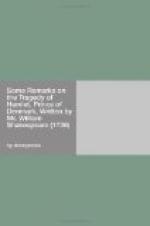This conservative side of Anonymous must not pass unnoticed, for it is the part of him that most closely identifies him with his forebears and so throws his more original, independent side into stronger relief. Our author is, not unexpectedly, an invariable moralist; is throughout a stickler for dignity; is sensitive to absurdities, improprieties, and slips in decorum; will have no truck with tragi-comedy in any of its forms. He hates puns and bombast, demands refinement in speech and restraint in manners. He regards Hamlet’s speeches to Ophelia in the Player scene as a violation of propriety, is shocked by the lack of decency in the representation of Ophelia’s madness, finds Hamlet’s frequent levity and the buffoonery of Polonius alike regrettable —Shakespeare’s favorite foible, he feels, is “that of raising a laugh.” The introduction of Fortinbras and his army on the stage is “an Absurdity”; the grave-diggers’ scene is “very unbecoming to tragedy”; the satire on the “Children of the Chapel” is not allowable in this kind of piece.
In all these things Anonymous is an upholder of the tradition of true, restrained wit. But unlike some of his contemporaries, he has a formula for discounting faults. “But we should be very cautious in finding Fault with Men of such exalted Genius as our Author certainly was, lest we should blame them when in reality the Fault lies in our own slow Conceptions ...” This is the language of tolerance, a tolerance that can overlook faults for the sake of greater beauties—one of the distinct marks of the new criticism to which the Remarks belongs.
The essay starts out in a boldly challenging tone. Criticism, says the author, has been badly abused: it has been regarded as an excuse for the ill-natured to find fault or for the better-natured to eulogize. But true criticism has for its end “to set in the best light all Beauties, and to touch upon Defects no more than is necessary.” Beyond this it seeks to set up a right taste for the age. His own purpose is to examine a great tragedy “according to the Rules of Reason and Nature, without having any regard to those Rules established by arbitrary Dogmatizing Critics ...” More specifically, he proposes to show the why of our pleasure in this piece: “And as to those things which charm by a certain secret Force, and strike us we know not how, or why; I believe it will not be disagreeable, if I shew to everyone the Reason why they are pleas’d ...” This, it need hardly be observed, is all pretty much in the vein of Addison, whom the author extols and whose papers on Paradise Lost, he tells us, have furnished a model for the present undertaking. Throughout his criticism Addison had deprecated mere fault-finding and had urged the positive approach of emphasis on beauties. In the last twelve essays on Milton’s poem he had shown a new way in critical writing, the way of particular as opposed to general criticism, with the selection of specific details for




